
Scots Monastery, Regensburg
Encyclopedia
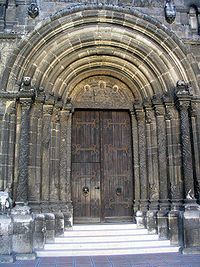
Benedictine
Benedictine refers to the spirituality and consecrated life in accordance with the Rule of St Benedict, written by Benedict of Nursia in the sixth century for the cenobitic communities he founded in central Italy. The most notable of these is Monte Cassino, the first monastery founded by Benedict...
abbey of St James (Jakobskirche) in Regensburg
Regensburg
Regensburg is a city in Bavaria, Germany, located at the confluence of the Danube and Regen rivers, at the northernmost bend in the Danube. To the east lies the Bavarian Forest. Regensburg is the capital of the Bavarian administrative region Upper Palatinate...
, Germany
Germany
Germany , officially the Federal Republic of Germany , is a federal parliamentary republic in Europe. The country consists of 16 states while the capital and largest city is Berlin. Germany covers an area of 357,021 km2 and has a largely temperate seasonal climate...
. It was founded by Hiberno-Scottish mission
Hiberno-Scottish mission
The Hiberno-Scottish mission was a mission led by Irish and Scottish monks which spread Christianity and established monasteries in Great Britain and continental Europe during the Middle Ages...
aries and for most of its history was in the hands of first Irish
Ireland
Ireland is an island to the northwest of continental Europe. It is the third-largest island in Europe and the twentieth-largest island on Earth...
, then Scottish
Scotland
Scotland is a country that is part of the United Kingdom. Occupying the northern third of the island of Great Britain, it shares a border with England to the south and is bounded by the North Sea to the east, the Atlantic Ocean to the north and west, and the North Channel and Irish Sea to the...
monks, whence its name (in German
German language
German is a West Germanic language, related to and classified alongside English and Dutch. With an estimated 90 – 98 million native speakers, German is one of the world's major languages and is the most widely-spoken first language in the European Union....
Schottenkirche, Schottenkloster or Schottenstift. In Middle Latin, Scotti meant Gael
Gaël
Gaël is a commune in the Ille-et-Vilaine department of Brittany in north-western France.It lies southwest of Rennes between Saint-Méen-le-Grand and Mauron...
s from Scotland or Ireland, so that the term Schottenstift already dates from the Irish period.) The full official name of the actual church, the most prominent building within the abbey complex, is Die irische Benediktinerklosterkirche St. Jakob und St. Gertrud (literally: "The Irish Benedictine Abbey Church of St. James and St. Gertrude").
Architecture
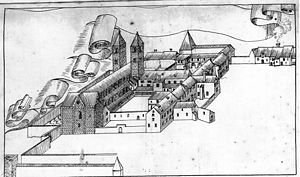
The abbey complex consisted of a number of buildings. The two most significant structures, the church and the cloister, both survive. The cloister is however significantly altered, having been destroyed by fires in 1278 and 1546, and rebuilt between 1866 and 1872. The entire complex was originally surrounded by a wall, which separated a cemetery to the north of the church from the street that led westwards out of the city.
Church

A new church, the structure which has substantially survived up to the present day, was constructed at some point between 1175-80. It is an example of Romanesque architecture
Romanesque architecture
Romanesque architecture is an architectural style of Medieval Europe characterised by semi-circular arches. There is no consensus for the beginning date of the Romanesque architecture, with proposals ranging from the 6th to the 10th century. It developed in the 12th century into the Gothic style,...
: a three-aisled basilica with three apses, towers at the east, and a transept at the west. A gallery, in which an organ has since been installed, extends over all three aisles in the transept.

Under the triumphal arch at the entrance to the central apse stand three wooden sculptures of the late twelfth century, which together form a crucifixion scene. They originally stood on the altar, but were repainted in 1874 and set in their present position in 1893. The apse itself was decorated between 1866 and 1872 by Bavarian and Austrian artists in a Romanesque revival style.
Schottenportal

Tympanum (architecture)
In architecture, a tympanum is the semi-circular or triangular decorative wall surface over an entrance, bounded by a lintel and arch. It often contains sculpture or other imagery or ornaments. Most architectural styles include this element....
, archivolt
Archivolt
An archivolt is an ornamental molding or band following the curve on the underside of an arch. It is composed of bands of ornamental moldings surrounding an arched opening, corresponding to the architrave in the case of a rectangular opening...
, and jambs formed an original composition of the 12th century, while the remaining portions of the Schottenportal were assembled from spolia
Spolia
Spolia is a modern art-historical term used to describe the re-use of earlier building material or decorative sculpture on new monuments...
during the Renaissance. While this theory would have absolved art historians of the duty of interpreting the program as a unified whole, it has not met with wide acceptance. Indeed, a thorough examination of the structure seems to have demonstrated conclusively that the entire portal was assembled in the late 12th century, simultaneously with the construction of the second church.
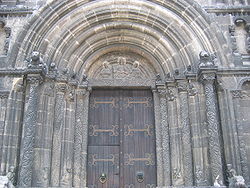
The interpretation of the tympanum is relatively uncontroversial: it portrays Christ, at the center, flanked by Sts. James and John. Numerous explanations for the remaining figures have been proposed; here only that of Richard Strobel has been presented.
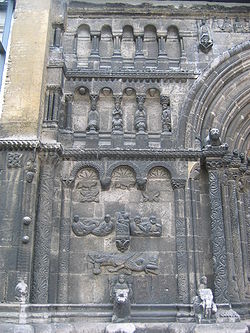
Interlace (visual arts)
In the visual arts, interlace is a decorative element found in medieval art. In interlace, bands or portions of other motifs are looped, braided, and knotted in complex geometric patterns, often to fill a space. Islamic interlace patterns and Celtic knotwork share similar patterns, suggesting a...
, while that at right is undecorated; the arcade in the middle zone is filled by a row of human heads, while that at right is filled with those of animals. The central sculpture in the lowest zone at left, which is set on a throne and projects significantly from the ground, clearly represents Mary with the Christ child; the former, as the "new Eve," holds an apple, while the latter holds the book of life. The reliefs at either side show human figures caressing each other, that is, in attitudes of harmony. The corresponding central figure on the lowest zone at right, on the other hand, is bracketed by aggressive, hostile beasts; this may represent the Antichrist
Antichrist
The term or title antichrist, in Christian theology, refers to a leader who fulfills Biblical prophecies concerning an adversary of Christ, while resembling him in a deceptive manner...
.
However, if the central figures at left and right are understood to stand for good and evil, respectively, the reliefs beneath them seem to represent a reversal of the situation. At left, a dragon is shown swallowing a lion, while at the lowermost level a siren appears, a symbol of temptation. At right, a crocodile is shown swalling a hydrus, wrapped in a ball of clay. According to a medieval legend, the hydrus, once inside, would destroy the crocodile from within; the story was understood to represent the Harrowing of Hell
Harrowing of Hell
The Harrowing of Hell is a doctrine in Christian theology referenced in the Apostles' Creed and the Athanasian Creed that states that Jesus Christ "descended into Hell"...
. At the lowermost level monks are depicted with gospel books in hand, thus pilgrims and missionaries. Therefore, if the central figures at left are auspicious, while those at right carry negative connotations, the exact opposite situation prevails at the lowest levels.
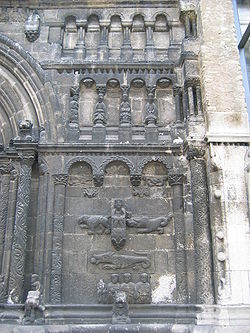
The uppermost register, in which Christ appears flanked by the twelve apostles, is most likely a representation of the Last Judgment
Last Judgment
The Last Judgment, Final Judgment, Day of Judgment, Judgment Day, or The Day of the Lord in Christian theology, is the final and eternal judgment by God of every nation. The concept is found in all the Canonical gospels, particularly the Gospel of Matthew. It will purportedly take place after the...
. It remains only to describe the jambs, which are decorated with a striking array of ornament, and at top and bottom with a variety of kneeling figures. The identities of some of these figures may be ascertained through their attributes. For example, the foremost figure at the lower right holds a t-shaped staff, which accessory was commonly associated with hermits and monks. The central figure at the upper right plays a bowed instrument, while the innermost figure at the upper left holds a vessel on which animal pelts are draped. These figures may refer to the history of the monastery itself: the monk with his staff to its origin among the hermits of Ireland; the musician to their position within the courtly society of Regensburg; and the fur-trader to their involvement with mercantile expeditions to Kiev
Kiev
Kiev or Kyiv is the capital and the largest city of Ukraine, located in the north central part of the country on the Dnieper River. The population as of the 2001 census was 2,611,300. However, higher numbers have been cited in the press....
.
As the portal reliefs have suffered from exposure to the elements, it was decided to enclose them within a glass vestibule. The work began in 1999, and was completed in 2000.
Irish period
The monastery was founded in the 12th century by Scotti, that is, GaelGaël
Gaël is a commune in the Ille-et-Vilaine department of Brittany in north-western France.It lies southwest of Rennes between Saint-Méen-le-Grand and Mauron...
s. (See Hiberno-Scottish mission
Hiberno-Scottish mission
The Hiberno-Scottish mission was a mission led by Irish and Scottish monks which spread Christianity and established monasteries in Great Britain and continental Europe during the Middle Ages...
.) Since at this period the term Scotti did not distinguish between the two parts of Gaeldom, some of the "Scots" monks may have come from what is now Scotland, but the majority would have been from Ireland. Regensburg was an important centre for the Irish mission to central Europe, and the Scots monastery in Vienna
Schottenstift, Vienna
The Schottenstift or Scottish Abbey is a Roman Catholic monastery founded in Vienna in 1155 when Henry II brought Irish monks to Vienna. The monks did not come directly from Ireland, but came instead from St Jakob's, the Irish monastery in Regensburg, Germany...
was a daughter establishment of St. Jakob. (See Celtic Christianity
Celtic Christianity
Celtic Christianity or Insular Christianity refers broadly to certain features of Christianity that were common, or held to be common, across the Celtic-speaking world during the Early Middle Ages...
). The monks had a strong relationship with the famous school at Cashel
Cashel, County Tipperary
Cashel is a town in South Tipperary in Ireland. Its population was 2936 at the 2006 census. The town gives its name to the ecclesiastical province of Cashel. Additionally, the cathedra of the Roman Catholic Archdiocese of Cashel and Emly was originally in the town prior to the English Reformation....
.
Honorius Augustodunensis
Honorius Augustodunensis
Honorius Augustodunensis , commonly known as Honorius of Autun, was a very popular 12th-century Christian theologian who wrote prolifically on many subjects. He wrote in a non-scholastic manner, with a lively style, and his works were approachable for the lay community in general...
(died ca. 1151), a highly influential medieval theologian, spent the last years of his life in the monastery. It is also possible that the 12th-century Middle High German Kaiserchronik
Kaiserchronik
The Kaiserchronik is a 12th century chronicle of emperors, written 17,283 lines of Middle High German verse. It runs from Julius Caesar to Conrad III, and seeks to give a complete account of the history of Roman and German emperors and kings, based on a historiographical view of the continuity of...
was written here, though this is disputed. The foundation of the monastery is described, for example, by Konrad von Megenberg in chapter six of his De limitibus parochiarum civitatis Ratisbonensis.
Scottish period
A papal bullPapal bull
A Papal bull is a particular type of letters patent or charter issued by a Pope of the Catholic Church. It is named after the bulla that was appended to the end in order to authenticate it....
of 1577 transferred the monastery from Irish hands to abbots from Scotland. The Scottish monks were predominantly from lowland Scotland, and thus were generally not Gaels. The effect of the bull was therefore a complete break in the continuity of the abbey's tradition. In part it may have been motivated by the fact that the word Scotti had by this time come to mean 'Scots' in the modern sense, allowing the new abbots to claim that the Irish possession had always been illegitimate. It was also partly because the Irish community in Regensburg was in any case in terminal decline: the last Irish abbot had just died leaving a single monk and one novice.
The first Scottish abbot was Ninian Winzet
Ninian Winzet
Ninian Winzet was a polemical writer who was probably educated at the university of Glasgow.He was ordained priest in 1540, and in 1552 was appointed master of the grammar school of Linlithgow, from which town he was later "expellit and schott out" by the partisans of Dean Patrick Kinlochy,...
(icon, see yogh
Yogh
The letter yogh , was used in Middle English and Older Scots, representing y and various velar phonemes. It was derived from the Old English form of the letter g.In Middle English writing, tailed z came to be indistinguishable from yogh....
), the controversial critic of John Knox
John Knox
John Knox was a Scottish clergyman and a leader of the Protestant Reformation who brought reformation to the church in Scotland. He was educated at the University of St Andrews or possibly the University of Glasgow and was ordained to the Catholic priesthood in 1536...
, who had been charged by Mary, Queen of Scots, with the task of providing priests for Scotland. However it was not until the early 17th century that the abbey was able to send missionaries to Scotland. From 1623 this was done in co-operation with English
England
England is a country that is part of the United Kingdom. It shares land borders with Scotland to the north and Wales to the west; the Irish Sea is to the north west, the Celtic Sea to the south west, with the North Sea to the east and the English Channel to the south separating it from continental...
Benedictines at Douai
Douai
-Main sights:Douai's ornate Gothic style belfry was begun in 1380, on the site of an earlier tower. The 80 m high structure includes an impressive carillon, consisting of 62 bells spanning 5 octaves. The originals, some dating from 1391 were removed in 1917 during World War I by the occupying...
, France
France
The French Republic , The French Republic , The French Republic , (commonly known as France , is a unitary semi-presidential republic in Western Europe with several overseas territories and islands located on other continents and in the Indian, Pacific, and Atlantic oceans. Metropolitan France...
.
Under the leadership of abbot Charles Arbuthnot
Charles Arbuthnot (abbot)
Charles Arbuthnot was a renowned Scottish abbot of the Scots Monastery, Regensburg, and a leading Bavarian mathematician of his time....
(1775-1820), the Scots Monastery was uniquely successful in avoiding the secularisation
German Mediatisation
The German Mediatisation was the series of mediatisations and secularisations that occurred in Germany between 1795 and 1814, during the latter part of the era of the French Revolution and then the Napoleonic Era....
of religious houses of the Napoleonic period, although after the death of Arbuthnot it was demoted to a priory. The Scots presence ended in 1862, when the government of Bavaria bought the monastery for use as a seminary.
Scottish abbots 1560-1820
(incomplete list)- c.1560-1592 Ninian WinzetNinian WinzetNinian Winzet was a polemical writer who was probably educated at the university of Glasgow.He was ordained priest in 1540, and in 1552 was appointed master of the grammar school of Linlithgow, from which town he was later "expellit and schott out" by the partisans of Dean Patrick Kinlochy,...
- 1608 John VII
- 1692 Placidus Flemming
- 1742 Bernard Stuart
- 1775-1820 Charles ArbuthnotCharles Arbuthnot (abbot)Charles Arbuthnot was a renowned Scottish abbot of the Scots Monastery, Regensburg, and a leading Bavarian mathematician of his time....
Current use
In 1862 the abbey was reopened as a seminary (training college) for priests, belonging to the local German diocese of the Catholic Church.Library
The medieval library built up by the Irish monks included many manuscript treasures. It is possible that it also contained parts of the library of the VienneseVienna
Vienna is the capital and largest city of the Republic of Austria and one of the nine states of Austria. Vienna is Austria's primary city, with a population of about 1.723 million , and is by far the largest city in Austria, as well as its cultural, economic, and political centre...
abbey. When the two last Scots monks finally left Regensburg in 1862, Anselm Robertson of Fochabers
Fochabers
Fochabers is a village in the Parish of Bellie, in Moray, Scotland, not far from the cathedral city of Elgin and located on the east bank of the River Spey. Around 2,000 people live in the village, which enjoys a rich musical and cultural history...
, the last prior, transported many of the greatest treasures to the Benedictine Abbey at Fort Augustus
Fort Augustus Abbey
Fort Augustus Abbey, properly St. Benedict's Abbey, at Fort Augustus, Inverness-shire, Scotland, was a Benedictine monastery, from late in the nineteenth century to 1998.-History:...
, which closed in 1998, when the Regensburg books and manuscripts were transferred to the National Library of Scotland
National Library of Scotland
The National Library of Scotland is the legal deposit library of Scotland and is one of the country's National Collections. It is based in a collection of buildings in Edinburgh city centre. The headquarters is on George IV Bridge, between the Old Town and the university quarter...
and the Scottish Catholic Archives in Edinburgh.
Pride of place goes to a volume of texts written in 1080 by the Irish Benedictine monk Marianus
Blessed Marianus Scotus
Blessed Marianus Scotus, aka Muiredach mac Robartaig, Irish abbot and scribe.-Origins:Baptised Muiredach mac Robartaig, he became known as Marianus Scotus, a Latinazition of his first name with the appellation Scotus indicating his Irish background. He was born sometime before the middle of the...
, the founder of the community at Regensburg. This contains, in Marianus's hand, the earliest written Gaelic
Goidelic languages
The Goidelic languages or Gaelic languages are one of the two branches of the Insular Celtic languages, the other consisting of the Brythonic languages. Goidelic languages historically formed a dialect continuum stretching from the south of Ireland through the Isle of Man to the north of Scotland...
words to be found in any work in Scotland. There is also a translation of a Latin
Latin
Latin is an Italic language originally spoken in Latium and Ancient Rome. It, along with most European languages, is a descendant of the ancient Proto-Indo-European language. Although it is considered a dead language, a number of scholars and members of the Christian clergy speak it fluently, and...
text into Scots, made in 1596 by Fr James Dalrymple
James Dalrymple
James Dalrymple may refer to:*James Dalrymple, 1st Viscount of Stair *Sir James Dalrymple, 1st Baronet , second son of the above*James Dalrymple, 3rd Earl of Stair*Jamie Dalrymple , English cricketer...
and seen as of great importance as a Scots language
Scots language
Scots is the Germanic language variety spoken in Lowland Scotland and parts of Ulster . It is sometimes called Lowland Scots to distinguish it from Scottish Gaelic, the Celtic language variety spoken in most of the western Highlands and in the Hebrides.Since there are no universally accepted...
text.
Sources
- Lore Conrad: Die Bildsymbolsprache der romanischen Schottenkirche in Regensburg. 6th edition. Regensburg 1993, ISBN 3-9800355-5-7
- Helmut Flachenecker: Schottenklöster. Irische Benediktinerkonvente im hochmittelalterlichen Deutschland. Paderborn, 1995, ISBN 3-506-73268-4
- Elgin von Gaisberg: Das Schottenportal in Regensburg. Bauforschung und Baugeschichte. Regensburg 2005, ISBN 3-937527-07-9
- Paul Mai, ed.: Scoti peregrini in St. Jakob. Regensburg, 2005, ISBN 3-7954-1775-9
- Helmut-Eberhard Paulus et al., eds.: Romanik in Regensburg. Kunst, Geschichte, Denkmalpflege. Regensburg 1996, ISBN 3-7954-1095-9
- Alasdair Roberts: Regensburg and the Scots, Aberdeen 2005.
- Mona Stocker: Die Schottenkirche St. Jakob in Regensburg: Skulptur und stilistisches Umfeld. Regensburg 2001, ISBN 3-930480-56-5
- Richard Strobel: Schottenkirche St. Jakob, Regensburg (=Schnell Kunstführer Nr. 691). 18th edition, Regensburg 2006, ISBN 3-7954-4437-3
- Richard Strobel and Markus Weis: Romanik in Altbayern. Zodiaque-Echter, Würzburg 1994, ISBN 3-429-01616-9

